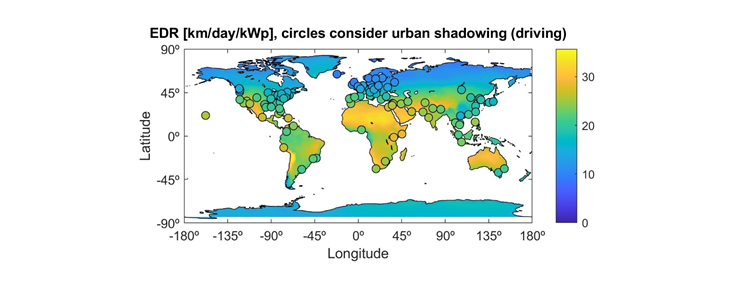Sign up for daily news updates from CleanTechnica on email. Or follow us on Google News!
Despite the rapid adoption of electric vehicles, the transport sector is still responsible for around a third of global carbon dioxide (CO2) emissions worldwide. Therefore, to achieve decarbonization targets, it is required to significantly decrease the emissions associated with mobility.

Radiation sensor on top of a vehicle (Source image credit: Miguel Centeno Brito., ULisboa Sciences)
The integration of photovoltaic modules into electric vehicles, solar cars, can contribute to this objective, reducing CO2 emissions associated with electricity generation and charging costs and frequency, with benefits for users and the electrical grid itself.
A new study developed by researchers from Ciências ULisboa and Instituto Dom Luiz with the collaboration of partners in France (Mines Paris – PSL) and Luxembourg (LIST), published in the journal Progress in Photovoltaics: Research and Applications, explores the potential in an urban environment of solar vehicles in 100 cities on five continents.
The results indicate that solar energy provides a range of between 11 and 29 km per day, reducing charging needs by half. The study also finds that the most favorable locations for solar-powered vehicles are cities in Africa, the Middle East, southern Europe, and Southeast Asia, although the potential is interesting in other geographies, including China, North America, and Australia. Losses associated with shading in the city are around 25%, and therefore relevant, but not an impediment to the large-scale dissemination of this solution.
The project‘s research group launched an experimental campaign with citizen scientists to experimentally validate the model.
“Cities are today the main market for electric vehicles and, due to the relatively small travelled distances, are particularly interesting for solar-powered vehicles. However, in urban areas, we have buildings, trees and other obstacles casting shadows onto the roads thus limiting the solar potential of driving or parked vehicles. The purpose of the work was to assess if the impact of these shadows is a significant limitation to the potential of solar cars,” explains Miguel Centeno Brito, first author of this study, researcher at Instituto Dom Luiz – IDL, at the Faculty of Sciences of the University of Lisbon (Ciências ULisboa) (Portugal). (Newswise)
With growing urban populations and concerns about environmental sustainability becoming increasingly urgent, solar-powered vehicles could not come at a more opportune time. “Our results can help establish a roadmap for policymakers and the automotive industry to accelerate the transition to a more sustainable and environmentally friendly urban future,” concludes Miguel Centeno Brito.
This worldwide study was developed by researchers from Ciências ULisboa (Portugal), in collaboration with partners in France (Mines Paris – PSL) and Luxembourg (LIST).
The study: Effect of urban shadowing on the potential of solar-powered vehicles
Republished from Faculty of Sciences of the University of Lisbon.
Related: The Solar Cars project at the Faculty of Sciences of the University of Lisbon
Have a tip for CleanTechnica? Want to advertise? Want to suggest a guest for our CleanTech Talk podcast? Contact us here.
EV Obsession Daily!
I don’t like paywalls. You don’t like paywalls. Who likes paywalls? Here at CleanTechnica, we implemented a limited paywall for a while, but it always felt wrong — and it was always tough to decide what we should put behind there. In theory, your most exclusive and best content goes behind a paywall. But then fewer people read it!! So, we’ve decided to completely nix paywalls here at CleanTechnica. But…
Thank you!
Tesla Sales in 2023, 2024, and 2030
CleanTechnica uses affiliate links. See our policy here.




